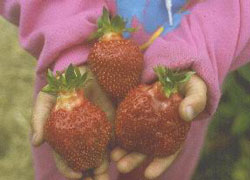


Home
Flowers &
Indoor Plants
Fruits & Nuts
Ornamentals
Vegetables
Special Topics
Resources
Glossary

|
Strawberry Fragaria x Ananassa (frah-gar-ee-ah ah-nah-nah-sah)    Click on thumbnails for larger image. |
 |
What about it? Worldwide, the strawberry is found in every country from the Arctic to the tropics. It is more widely distributed than any other fruit, including the grape. This is the result of the widespread appeal of strawberry fruits, and the broad environmental tolerance of the plant. Currently, New York State gardeners grow both June-bearing and "dayneutrar types. The dayneutrals fruit and flower as long as temperatures are between about 35-85 degrees F., and are not daylength dependent. What is it used for? Strawberries are principally used as fresh fruit. They are also used in processed forms such as cooked and sweetened preserves, jams or jellies, and frozen whole berries. Nutritionally, strawberries are valued as a low-calorie carbohydrate and a high source of vitamin C and fiber. Where does it grow? How do we grow it? The ideal soil for strawberry production is a well-drained loam that is high in organic matter. However, strawberries will tolerate a broad range of soil types, providing the site is well-drained. Plant strawberries 12 to 18 inches apart in rows that are 48 inches apart. Dayneutrals are planted much more closely. Healthy June-bearing strawberry plants are renovated after harvest. This involves running them over with a lawnmower (honest!). What are its primary problems? Weeds are the bane of the strawberry gardener. Fast-spreading grasses will practically "choke out" the strawberry by stealing its water and nutrient supply. Pests such as strawberry aphids, strawberry weevils, and strawberry crown borers love strawberries as much as humans do. Slugs can cause considerable damage as well. Common diseases include grey mold, leaf spots, powdery mildew, and red stele root rot, root nematodes, and various viruses. Black or brown rot is a widespread problem that is caused by several factors including winter injury and poor soil drainage. How do we harvest and store it? Pick strawberries the day they are ripe. They should be slightly soft and brightly colored. Pick the stem and cap as well. One strawberry plant will produce about a pint of berries when mature. Refrigerate the berries after picking.
© Copyright, Department of Horticulture, Cornell University. |